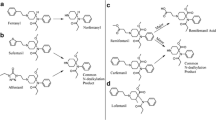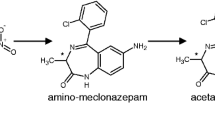Abstract
Purpose
The metabolism of carfentanil was assessed using human, dog, and rat pulmonary microsomes. Mass spectrometry based analysis allowed for metabolite identification and species differentiation. Participation of different metabolic enzymes in carfentanil biotransformation was also assessed.
Methods
Metabolite profiling was accomplished by incubating 10 µM carfentanil in human, dog, and rat lung microsomes. The metabolites were separated and analyzed by ultra-high performance liquid chromatography/high-resolution mass spectrometry.
Results
In total, 18 metabolites were detected. Nine metabolites were authentically identified through comparison to synthesized reference standards. In human lung microsomes, nine metabolites were identified. In dog lung microsomes, 15 metabolites were identified with three being dog specific. In rat lung microsomes, 15 metabolites were identified and two were rat specific. Proposed metabolic pathways included N-dealkylation, monohydroxylation, dihydroxylation, N-oxidation of piperidine ring nitrogen, and ketone formation. Participation of enzymes CYP2B6, CYP2E1, CYP2J2, and CYP3A4/5 to carfentanil metabolism was suggested by selective enzymatic inhibition.
Conclusions
The pulmonary clearance in human lung microsomes was lower than the previously reported hepatic metabolism suggesting organ specific metabolic rates. The contribution of multiple cytochrome P450 enzymes to human, dog, and rat pulmonary microsomal carfentanil biotransformation varied between species. The identified metabolites may provide useful markers for possible forensic and clinical determination of the mode of ingestion but the use of dog and rat animal models was not indicated. To our knowledge, this is the first reported use of chemically synthesized reference standards for the unequivocal identification of lung carfentanil metabolites.





Similar content being viewed by others
References
Lust EB, Barthold C, Malesker MA, Wichman TO (2011) Human health hazards of veterinary medications: information for emergency departments. J Emerg Med 40:198–207. https://doi.org/10.1016/j.jemermed.2009.09.026
Shafer SL (2019) Carfentanil: a weapon of mass destruction. Can J Anesth 66:351–355. https://doi.org/10.1007/s12630-019-01295-x
Leen JLS, Juurlink DN (2019) Carfentanil: a narrative review of its pharmacology and public health concerns. Can J Anesth 66:414–421. https://doi.org/10.1007/s12630-019-01294-y
Haigh JC, Lee LJ, Schweinsburg RE (1983) Immobilization of polar bears with carfentanil. J Wildl Dis 19:140–144. https://doi.org/10.7589/0090-3558-19.2.140
Schumacher J, Heard DJ, Young L, Citino SB (1997) Cardiopulmonary effects of carfentanil in dama gazelles (Gazella dama). J Zoo Wildl Med 28:166–170
Neumann G, Erhardt W, Oberhuber B, Fritsch R, Blümel G (1980) A new highly potent and short-acting analgesic, carfentanil (R33799), in combination with the hypnotic agent, etomidat (R26490), as a method of anaesthesia in guinea-pigs. Res Exp Med 177:135–143. https://doi.org/10.1007/bf01851842
Mutlow A, Isaza R, Carpenter JW, Koch DE, Hunter RP (2004) Pharmacokinetics of carfentanil and naltrexone in domestic goats (Capra hircus). J Zoo Wildl Med 35:489–496. https://doi.org/10.1638/03-074
Cole A, Mutlow A, Isaza R, Carpenter JW, Koch DE, Hunter RP, Dresser BL (2006) Pharmacokinetics and pharmacodynamics of carfentanil and naltrexone in female common eland (Taurotragus oryx). J Zoo Wildl Med 37:318–326. https://doi.org/10.1638/05-070.1
Uddayasankar U, Lee C, Oleschuk C, Eschun G, Ariano RE (2018) The pharmacokinetics and pharmacodynamics of carfentanil after recreational exposure: a case report. Pharmacotherapy 38:e41–e45. https://doi.org/10.1002/phar.2117
Rabiner EA, Beaver J, Makwana A, Searle G, Long C, Nathan PJ, Newbould RD, Howard J, Miller SR, Bush MA, Hill S, Reiley R, Passchier J, Gunn RN, Matthews PM, Bullmore ET (2011) Pharmacological differentiation of opioid receptor antagonists by molecular and functional imaging of target occupancy and food reward-related brain activation in humans. Mol Psychiatry 16:826–835. https://doi.org/10.1038/mp.2011.29(open access article)
Eriksson O, Antoni G (2015) [11C] Carfentanil binds preferentially to μ-opioid receptor subtype 1 compared to subtype 2. Mol Imaging 14:476–483. https://doi.org/10.2310/7290.2015.00019(open access article)
Heinz A, Reimold M, Wrase J, Hermann D, Croissant B, Mundle G, Dohmen BM, Braus DH, Schumann G, Machulla HJ, Bares R, Mann K (2005) Correlation of stable elevations in striatal mu-opioid receptor availability in detoxified alcoholic patients with alcohol craving—a positron emission tomography study using carbon 11-labeled carfentanil. Arch Gen Psychiatry 62:57–64. https://doi.org/10.1001/archpsyc.62.1.57
Reimold M, Hermann D, Reischl G, Smolka M, Batra A, Rietschel M, Kiefer F, Heinz A, Bares R, Mann K (2010) Reduced mu-opiate receptor availability in a genetic variant of the mu-opiate receptor (A118G): a [11C] carfentanil PET study. J Nucl Med 51(Suppl. 2):49 (only abstract available)
Weltrowska G, Lemieux C, Chung NN, Guo JJ, Wilkes BC, Schiller PW (2014) 'Carba'-carfentanil (trans isomer): a µ-opioid receptor (MOR) partial agonist with a distinct binding mode. Bioorg Med Chem 22:4581–4586. https://doi.org/10.1016/j.bmc.2014.07.033
Riches JR, Read RW, Black RM, Cooper NJ, Timperley CM (2012) Analysis of clothing and urine from Moscow theatre siege casualties reveals carfentanil and remifentanil use. J Anal Toxicol 36:647–656. https://doi.org/10.1093/jat/bks078(open access article)
Wax PM, Becker CE, Curry SC (2003) Unexpected "gas" casualties in Moscow: a medical toxicology perspective. Ann Emerg Med 41:700–705. https://doi.org/10.1067/mem.2003.148
Tiscione NB, Alford I (2018) Carfentanil in impaired driving cases and the importance of drug seizure data. J Anal Toxicol 42:476–484. https://doi.org/10.1093/jat/bky026(open access article)
Misailidi N, Papoutsis I, Nikolaou P, Dona A, Spiliopoulou C, Athanaselis S (2018) Fentanyls continue to replace heroin in the drug arena: the cases of ocfentanil and carfentanil. Forensic Toxicol 36:12–32. https://doi.org/10.1007/s11419-017-0379-4
Raffa RB, Pergolizzi JV Jr, LeQuang JA, Taylor R Jr, On behalf of NEMA Research Group, Colucci S, Annabi MH (2018) The fentanyl family: a distinguished medical history tainted by abuse. J Clin Pharm Ther 43:154–158. https://doi.org/10.1111/jcpt.12640(open access article)
Elliott SP, Lopez EH (2018) A series of deaths involving carfentanil in the UK and associated post-mortem blood concentrations. J Anal Toxicol 42:e41–e45. https://doi.org/10.1093/jat/bkx109(open access article)
Olsson B, Bondesson E, Borgström L, Edsbäcker S, Eirefelt S, Ekelund K, Gustavsson L, Hegelund-Myrbäck T (2011) Pulmonary drug metabolism, clearance, and absorption. In: Smyth HDC, Hickey AJ (eds) Controlled pulmonary drug delivery. Springer, New York
Boer F (2003) Drug handling by the lungs. Br J Anaesth 91:50–60. https://doi.org/10.1093/bja/aeg117(open access article)
Thum T, Erpenbeck VJ, Moeller J, Hohlfeld JM, Krug N, Borlak J (2006) Expression of xenobiotic metabolizing enzymes in different lung compartments of smokers and nonsmokers. Environ Health Perspect 114:1655–1661. https://doi.org/10.1289/ehp.8861(open access article)
Castell JV, Donato MT, Gómez-Lechón MJ (2005) Metabolism and bioactivation of toxicants in the lung. The in vitro cellular approach. Exp Toxicol Pathol 57:189–204. https://doi.org/10.1016/j.etp.2005.05.008
Hukkanen J, Pelkonen O, Hakkola J, Raunio H (2002) Expression and regulation of xenobiotic-metabolizing cytochrome P450 (CYP) enzymes in human lung. Crit Rev Toxicol 32:391–411. https://doi.org/10.1080/20024091064273
Nhamburo PT, Gonzalez FJ, McBride OW, Gelboin HV, Kimura S (1989) Identification of a new P450 expressed in human lung: complete cDNA sequence, cDNA-directed expression, and chromosome mapping. Biochemistry 28:8060–8066. https://doi.org/10.1021/bi00446a014
Feasel MG, Wohlfarth A, Nilles JM, Pang SK, Kristovich RL, Huestis MA (2016) Metabolism of carfentanil, an ultra-potent opioid, in human liver microsomes and human hepatocytes by high-resolution mass spectrometry. AAPS J 18:1489–1499. https://doi.org/10.1208/s12248-016-9963-5
Martignoni M, Groothuis GMM, de Kanter R (2006) Species differences between mouse, rat, dog, monkey and human CYP-mediated drug metabolism, inhibition and induction. Expert Opin Drug Metab Toxicol 2:875–894. https://doi.org/10.1517/17425255.2.6.875
Hsu F-L, Walz AJ, Myslinski JM, Kong L, Feasel MG, Goralski TDP, Rose T, Cooper NJ, Roughley N, Timperley CM (2019) Synthesis and μ-opioid activity of the primary metabolites of carfentanil. ACS Med Chem Lett 10:1568–1572. https://doi.org/10.1021/acsmedchemlett.9b00404
Raunio H, Hakkola J, Hukkanen J, Lassila A, Päivärinta K, Pelkonen O, Anttila S, Piipari R, Boobis A, Edwards RJ (1999) Expression of xenobiotic-metabolizing CYPs in human pulmonary tissue. Exp Toxicol Pathol 51:412–417. https://doi.org/10.1016/s0940-2993(99)80031-1
Turpeinen M, Tolonen A, Uusitalo J, Jalonen J, Pelkonen O, Laine K (2005) Effect of clopidogrel and ticlopidine on cytochrome P450 2B6 activity as measured by bupropion hydroxylation. Clin Pharmacol Ther 77:553–559. https://doi.org/10.1016/j.clpt.2005.02.010
Walsky RL, Astuccio AV, Obach RS (2006) Evaluation of 227 drugs for in vitro inhibition of cytochrome P450 2B6. J Clin Pharmacol 46:1426–1438. https://doi.org/10.1177/0091270006293753
Eagling VA, Tjia JF, Back DJ (1998) Differential selectivity of cytochrome P450 inhibitors against probe substrates in human and rat liver microsomes. Br J Clin Pharmacol 45:107–114. https://doi.org/10.1046/j.1365-2125.1998.00679.x(open access article)
Ren S, Zeng J, Mei Y, Zhang JZH, Yan SF, Fei J, Chen L (2013) Discovery and characterization of novel, potent, and selective cytochrome P450 2J2 inhibitors. Drug Metab Dispos 41:60–71. https://doi.org/10.1124/dmd.112.048264
Patki KC, von Moltke LL, Greenblatt DJ (2003) In vitro metabolism of midazolam, triazolam, nifedipine, and testosterone by human liver microsomes and recombinant cytochromes P450: role of CYP3A4 and CYP3A5. Drug Metab Dispos 31:938–944. https://doi.org/10.1124/dmd.31.7.938
Cashman JR, Park SB, Yang ZC, Wrighton SA, Jacob P III, Benowitz NL (1992) Metabolism of nicotine by human liver microsomes: stereoselective formation of trans-nicotine N'-oxide. Chem Res Toxicol 5:639–646. https://doi.org/10.1021/tx00029a008
Pelkonen O, Turpeinen M, Uusitalo J, Rautio A, Raunio H (2005) Prediction of drug metabolism and interactions on the basis of in vitro investigations. Basic Clin Pharmacol Toxicol 96:167–175. https://doi.org/10.1111/j.1742-7843.2005.pto960305.x(open access article)
Acknowledgements
This work was funded by the Defense Threat Reduction Agency (DTRA) under Project number CB3662.
Author information
Authors and Affiliations
Corresponding author
Ethics declarations
Conflict of interest
The authors declare that they have no conflict of interest.
Ethical approval
This article does not contain any studies with human participants or animals performed by any of the authors.
Additional information
Publisher's Note
Springer Nature remains neutral with regard to jurisdictional claims in published maps and institutional affiliations.
Electronic supplementary material
Below is the link to the electronic supplementary material.
Rights and permissions
About this article
Cite this article
Kong, L., Walz, A.J. Mass spectrometric characterization of carfentanil metabolism in human, dog, and rat lung microsomes via comparison to chemically synthesized metabolite standards. Forensic Toxicol 38, 352–364 (2020). https://doi.org/10.1007/s11419-019-00521-x
Received:
Accepted:
Published:
Issue Date:
DOI: https://doi.org/10.1007/s11419-019-00521-x




